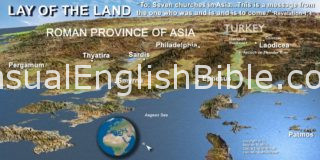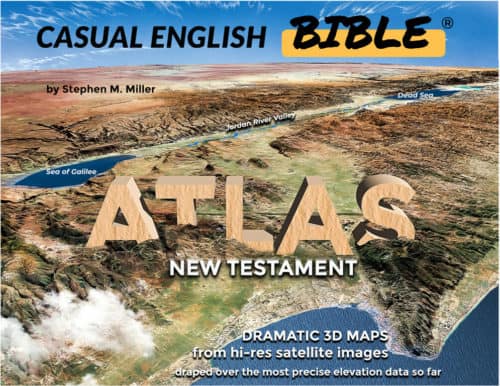
The universe, too, it seems.
“Earth and sky were gone . . . Both had served their purpose” (Revelation 20:11).
A mysterious man named John, exiled to an island, sees it all happen in a graphic and violent stream of unconsciousness: visions, trances, and perhaps out-of-body experiences. It’s hard to tell which.
An angel carries his spirit into God’s sprawling throne room in heaven. There he sees someone who talks like Jesus: “I was dead, but I’m alive for good now. I’ve shown that I’m stronger than death and the grave” (Revelation 1:18). This spirit being tells John, “Write down what you’re going to see that’s happening now and that’s yet to come” (verse 19).
Roman Horror Stories
Some of the horrors John reports sound very much like what first-century historians said Romans did to Christians.
Some details also sound like what happened to Christians and Jews living in the Jewish homeland when Romans invaded in AD 67 to crush a Jewish revolt. Romans leveled Jerusalem and destroyed what became the last Jewish Temple.
Later, Babylon—a code name for Rome—falls. John sees it and reports it, presumably, as a message of hope to Christians facing Roman persecution and martyrdom. Rome apparently got its code name “Babylon” because Romans did what Babylonians had done in 586 BC: they leveled Jerusalem and destroyed the Jewish Temple.
Some of John’s reporting doesn’t seem to fit on history’s timeline. John writes many events into the future.
He sees worldwide disasters that begin with a series of wars, famines, and diseases that wipe out a fourth of humanity. A massive earthquake erupts, leveling mountains and sinking islands. Then John says falling stars pummel humanity into what sounds like a new Stone Age. “Terrified, everyone hid in caves” (Revelation 6:15; see verses 12-15).
Satan mounts a final attack on God’s people, with coalition forces from nations all over the world. But a white-horse cavalry of celestial beings, led by Jesus it seems, destroys the army, captures Satan, and doggone well pitches him into a lake of fire.
New Jerusalem
An angel takes John to a mountaintop for the perfect view of New Jerusalem floating down from heaven. He says he saw the new heaven and earth God had made for his people. He said he heard a voice say, “Look at that! God has moved in with people! He’s going to live right there with them” (Revelation 21:3).
John doesn’t write in journalistic style, most Bible experts seem to agree. He writes in a genre that’s closer to poetry than prose: apocalyptic lit. It’s famous for its extreme symbolism and code words. That makes it hard to know when to take him literally or when to dive deeper and look for the hidden meaning—which might be tougher for us to figure out than it was for his readers who might have known the code.
Though it can be tough to follow John’s meaning from one dramatic scene to the next, it’s hard to miss where it all leads.
Bad guys lose. Satan is toast. Heaven is real.
Writer
Jesus’s disciple and close friend John wrote Revelation, according to some early Christian writers, including Irenaeus (about AD 130 to AD 202) and Polycrates (about AD 130 to AD 196).
But all the writer says about himself is this: “I, John, am your brother and your partner in all this suffering going on. . . . I was sent to the island of Patmos because I got caught telling people about Jesus” (Revelation 1:9).
Another contender with early support: John the Elder. His name is all we know about him. Yet a bishop named Papias (about AD 60 to AD 163) identifies him as the writer.
One clue that Jesus’s disciple John might not be the writer: when the writer refers to “the Lamb’s 12 apostles” (Revelation 21:14), he doesn’t say he’s one of them.
Timeline
John wrote Revelation in either the AD 60s, when Emperor Nero launched the first wave of Roman persecution against Christians, or in the AD 90s, when Emperor Domitian persecuted them for not worshiping him as a god. That’s the consensus among most Bible scholars.
 Location
Location
John wrote from exile on the island of Patmos about 40 miles (65 km) off Turkey’s west coast. He started the letter by addressing short messages to seven churches near the western coast. Early church writers say the apostle John and many other Christians had moved there to western Turkey in around AD 66, when Jews revolted against Rome. Some reports have John settling in the busy coastal town of Ephesus.
Perhaps the fleeing Christians remembered a warning Jesus gave his followers near the end of his ministry: “The next time you see an army surround Jerusalem, that’s your sign. That’s when you’ll know the city is about to get decimated. Those of you who are anywhere near the city—anywhere in the region of Judea—you’ll need to run to the mountains. Those of you inside the city will need to evacuate immediately. And if you’re living in the countryside, don’t go anywhere near the city” (Luke 21:20-21).
That would have been good advice in AD 70, when Romans surrounded Jerusalem and then leveled it that summer.
Destination of Letter
John starts the letter by addressing short notes to seven churches in the Roman province of Asia. That’s western Turkey today. First letter goes to the town where the apostle John reportedly settled: Ephesus. He added notes to six more: Smyrna, Pergamum, Thyatira, Sardis, Philadelphia, and Laodicea. Church members apparently copied those letters with the rest of the prophecies in Revelation and shared them with other churches, which is one reason Revelation ended up in the Bible.





